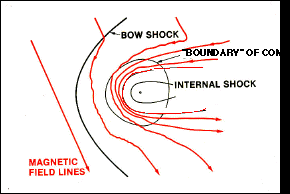This picture shows what happens when the molecules coming from the comet encounter interplanetary space.
Click on image for full size
JPL
The comet's interaction with interplanetary space, part 2
How Particles are Swept into the Tail
The magnetic field of the sun (the IMF) is distorted in passing over the comet, taking a long time to slip around the sizeable ion cloud which forms the comet coma. The stretched magnetic field lines form a long tail region as they slip around the nucleus, before finally straightening out, about a million miles later, to their original configuration.
Ions from the nucleus begin to circle around the field lines of the IMF and are thus carried into the tail region created by the stretched magnetic field lines. Once they begin gyrating around the magnetic field, ions are "stuck" to the field lines.
The movie below shows this process at work.
You might also be interested in:
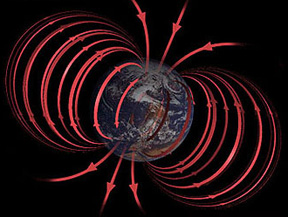
Magnetic fields can cause particles to move in these three ways: Spiral Motion Bounce Motion Drift Motion
...more
When evaporation begins, the gas is propelled from the nucleus at supersonic speed (depicted by arrows in the figure). Because of the low gravity in space, this means that the molecules from the nucleus
...more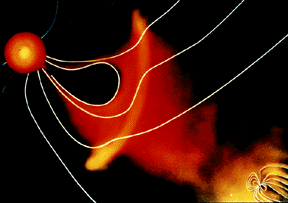
There is a giant magnetic "bubble" in space around the Sun. That "bubble" is called the heliosphere. In a sense, we Earthlings live within the outer atmosphere of our Sun. The solar
...more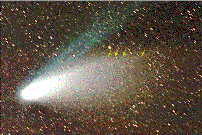
Hale-Bopp continues to offer new surprises as two astronomers report of their study of the comet. Using the Hubble Space Telescope and the International Ultraviolet Explorer, the astronomers did a year-long
...more
Six spacecraft flew by Halley's comet in 1986. There were two spacecraft launched from Japan, Suisei and Sakigake, and two from the Soviet Union, Vega 1 & 2. One spacecraft, ICE, from the United States
...more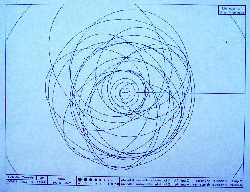
Comets are observed to go around the sun in a long period of time or a short period of time. Thus they are named "long-period" or "short-period" comets. One group of short-period comets, called the Jupiter
...more
Scientists have learned a great deal from the crash of comet Shoemaker-Levy 9. Scientists traced the orbit of the comet backwards in time to guess its origin. The crash of a comet like Shoemaker-Levy 9
...more


